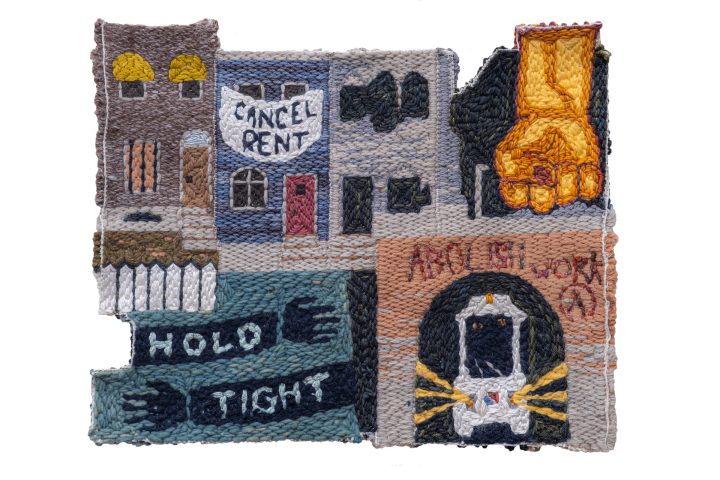
Tabitha Arnold is weaving a narrative of revolution into her spirited textiles. Based in Philadelphia, Arnold captures the fervor of recent political unrest in tufted wool rugs that exhibit a painterly attention to detail. Her art is a reflection of her own activism and a response to what she calls a “frustrating media landscape.” Each rug pays tribute to organizers who lay their bodies on the line in the workplace, in the public square, and in the depths of private prisons.
Many of Arnold’s colorful textiles are labor-intensive in style and substance, layering worker strikes and city protests across vertical compositions. She depicts vast assembly lines and hierarchies resembling the Pyramid of Capitalist System, a 20th-century caricature from Russian newspapers and Industrial Workers of the World propaganda. Arnold’s interest in fiber art originated at the Pennsylvania Academy of Fine Arts — where she discovered Ann Hamilton, Sheila Hicks, and Faith Ringgold — but her socialist worldview grew from more personal experience.
“I was raised by religious parents who voted Republican, and my earliest political memories are listening to right-wing commentary over news clips of Hurricane Katrina, the war in Iraq, and immigration at the US-Mexico border,” she told Hyperallergic. “When I moved to the city, I came to understand that our political reality is far from the propaganda I grew up hearing.”

While the Obama era left her feeling disillusioned with the liberal establishment, Arnold claims the 2016 presidential election forced her into action. She joined Reclaim Philadelphia to help elect socialist candidates to state and municipal office. In 2019, she began organizing in the food service industry with Philly Workers for Dignity and recently volunteered with the Democratic Socialists of America’s Green New Deal commission.
Union symbols like Scabby the Rat appear with anarchist slogans like “Cancel Rent” and “Abolish Work.” In the sprawling “Whose Streets” (2020), a flipped cop car is engulfed by a fire spirit, fueled by voices of Black and Brown women with fists raised. Arnold argues that abolitionist imagery helps to counter mainstream media’s ongoing campaign against uprisings in the US, encouraging free discussion of colonial domination and capitalist exploitation.

“In labor organizing, real power begins to spark when employees get together and share stories about what’s actually happening on the clock,” she said. “Beyond the manicured PR campaigns, pizza parties with the boss, and customer-facing smiles, there is a real narrative that is dangerous to capital when it’s unleashed.”
Arnold’s textiles are populist and devotional, projecting scenes of collective outrage into transcendence. To her, fiber art can convey a sense of familiarity while inviting groups of disparate viewers into conversation about widespread inequality and abuses of power. This is a philosophy exhibited by Mexican muralists and Soviet mosaic artists, but that also manifests in Afghan war rugs and the quilts of Gee’s Bend. Arnold invites these influences into conversation as well, laying the groundwork for new connections between art and organizing.


0 Commentaires